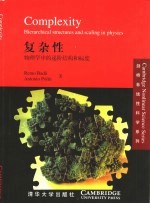

复杂性 影印版 物理学中的递阶结构和标度PDF电子书下载
- 电子书积分:12 积分如何计算积分?
- 作 者:(美)Remo.Badii,Anotoino.Politi著
- 出 版 社:北京:清华大学出版社
- 出版年份:2000
- ISBN:7302039038
- 页数:318 页
Part 1 Phenomenology and models 1
Chapter 1 Introduction 3
1.1 Statement of the problem 3
1.2 Historical perspective 7
1.3 Self-generated complexity 9
Chapter 2 Examples of complex behaviour 12
2.1 Instabilities in fluids 13
2.1.1 Temporally"complex"dynamics 13
2.1.2 Spatio-temporal"complexity" 15
2.2 Turbulence 17
2.3 Biological and chemical reactions 19
2.4 Optical instabilities 21
2.5 Growth phenomena 23
2.6 DNA 26
2.6.1 The genetic code 27
2.6.2 Structure and function 29
Chapter 3 Mathematical models 32
3.1 Reduction methods for partial differential equations 33
3.2 Ordinary differential equations 37
3.3 Mappings 39
3.3.1 Strange attractors 41
3.4 Cellular automata 48
3.4.1 Regular rules 51
3.4.2 Chaotic rules 53
3.4.3 "Complex"rules 53
3.5 Statistical mechanical systems 57
3.5.1 Spin glasses 60
3.5.2 Optimization and artificial neural networks 64
Part 2 Mathematical tools 67
Chapter 4 Symbolic representations of physical systems 69
4.1 Encoding in nonlinear dynamics 70
4.2 Shifts and invariant sets 76
4.2.1 Shift dynamical systems 77
4.3 Languages 78
4.3.1 Topological entropy 81
4.3.2 Substitutions 82
Chapter 5 Probability,ergodic theory,and information 85
5.1 Measure-preserving transformations 86
5.2 Stochastic processes 89
5.3 Time-evolution operators 93
5.4 Correlation functions 96
5.5 Ergodic theory 100
5.5.1 Spectral theory and isomorphism 104
5.5.2 Shift dynamical systems 105
5.5.3 What is the"generic"behaviour? 107
5.5.4 Approximation theories 108
5.6 Information,entropy,and dimension 109
Chapter 6 Thermodynamic formalism 119
6.1 Interactions 119
6.2 Statistical ensembles 123
6.2.1 Generalized entropies 123
6.2.2 Generalized dimensions 128
6.3 Phase transitions 132
6.3.1 Critical exponents,universality,and renormalization 134
6.3.2 Disordered systems 141
6.4 Applications 148
6.4.1 Power spectral measures and decay of correlation functions 148
6.4.2 Thermodynamics of shift dynamical systems 151
Part 3 Formal characterization of complexity 163
Chapter 7 Physical and computational analysis of symbolic signals 165
7.1 Formal languages,grammars,and automata 166
7.1.1 Regular languages 167
7.1.2 Context-free languages 170
7.1.3 Context-sensitive languages 175
7.1.4 Unrestricted languages 177
7.1.5 Other languages 183
7.2 Physical characterization of formal languages 184
7.2.1 Regular languages 184
7.2.2 Context-free languages 187
7.2.3 DOL languages 190
7.2.4 Context-sensitive and recursively enumerable languages 197
7.3 Computational characterization of physical systems and mathematical models 198
7.3.1 Dynamics at the borderline with chaos 198
7.3.2 Quasicrystals 200
7.3.3 Chaotic maps 202
7.3.4 Cellular automata 203
7.3.5 Relationship between Turing machines and dynamical systems 207
7.3.6 Nucleotide sequences 209
7.3.7 Discussion 211
Chapter 8 Algorithmic and grammatical complexities 213
8.1 Coding and data compression 214
8.2 Model inference 219
8.3 Algorithmic information 226
8.3.1 P-NP problems 230
8.4 Lempel-Ziv complexity 233
8.5 Logical depth 235
8.6 Sophistication 237
8.7 Regular-language and set complexities 240
8.8 Grammatical complexity 243
Chapter 9 Hierarchical scaling complexities 248
9.1 Diversity of trees 249
9.1.1 Horton-Strahler indices 252
9.2 Effective-measure and forecasting complexity 253
9.3 Topological exponents 255
9.4 Convergence of model predictions 260
9.4.1 Global prediction 260
9.4.2 Detailed prediction 262
9.5 Scaling function 270
Chapter 10 Summary and perspectives 277
Appendix 1 The Lorenz model 281
Appendix 2 The horseshoe map 283
Appendix 3 Mathematical definitions 285
Appendix 4 Lyapunov exponents,entropy,and dimension 287
Appendix 5 Forbidden words in regular languages 290
References 293
Index 311
- 《新编高中物理竞赛教程习题全解》钟小平主编;钟小平,倪国富,曹海奇编写 2019
- 《物联网导论》张翼英主编 2020
- 《数学物理方法与仿真 第3版》杨华军 2020
- 《中学物理奥赛辅导:热学 光学 近代物理学》崔宏滨 2012
- 《长江口物理、化学与生态环境调查图集》于非 2019
- 《大学物理简明教程 下 第2版》施卫主编 2020
- 《慢性呼吸系统疾病物理治疗工作手册》(荷)瑞克·考斯林克(RikGosselink) 2020
- 《医学物理学》洪洋 2020
- 《初中物理知识地图》赵端旭 2017
- 《教师教育系列教材 心理学原理与应用 第2版 视频版》郑红,倪嘉波,刘亨荣编;陈冬梅责编 2020
- 《SQL与关系数据库理论》(美)戴特(C.J.Date) 2019
- 《魔法销售台词》(美)埃尔默·惠勒著 2019
- 《看漫画学钢琴 技巧 3》高宁译;(日)川崎美雪 2019
- 《优势谈判 15周年经典版》(美)罗杰·道森 2018
- 《社会学与人类生活 社会问题解析 第11版》(美)James M. Henslin(詹姆斯·M. 汉斯林) 2019
- 《海明威书信集:1917-1961 下》(美)海明威(Ernest Hemingway)著;潘小松译 2019
- 《迁徙 默温自选诗集 上》(美)W.S.默温著;伽禾译 2020
- 《上帝的孤独者 下 托马斯·沃尔夫短篇小说集》(美)托马斯·沃尔夫著;刘积源译 2017
- 《巴黎永远没个完》(美)海明威著 2017
- 《剑桥国际英语写作教程 段落写作》(美)吉尔·辛格尔顿(Jill Shingleton)编著 2019
- 《大学计算机实验指导及习题解答》曹成志,宋长龙 2019
- 《指向核心素养 北京十一学校名师教学设计 英语 七年级 上 配人教版》周志英总主编 2019
- 《大学生心理健康与人生发展》王琳责任编辑;(中国)肖宇 2019
- 《大学英语四级考试全真试题 标准模拟 四级》汪开虎主编 2012
- 《大学英语教学的跨文化交际视角研究与创新发展》许丽云,刘枫,尚利明著 2020
- 《北京生态环境保护》《北京环境保护丛书》编委会编著 2018
- 《复旦大学新闻学院教授学术丛书 新闻实务随想录》刘海贵 2019
- 《大学英语综合教程 1》王佃春,骆敏主编 2015
- 《大学物理简明教程 下 第2版》施卫主编 2020
- 《指向核心素养 北京十一学校名师教学设计 英语 九年级 上 配人教版》周志英总主编 2019
